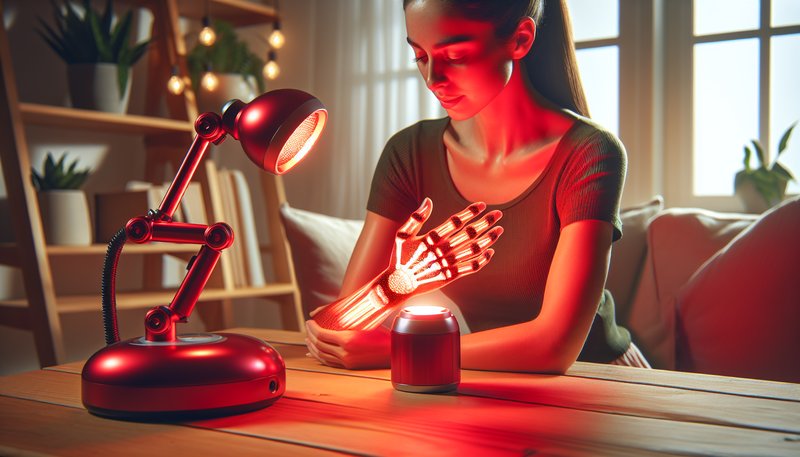Can Red Light Therapy Help Arthritis?
Is chronic joint pain keeping you from enjoying life to the fullest? As arthritis affects millions, it’s important to explore potential relief options, including emerging treatments such as red light therapy.
This article will delve into what red light therapy is, its potential benefits for arthritis sufferers, considerations before starting treatment, alternatives available, and expert insights to help you make informed decisions about your pain management options.
Key Takeaways
- Red light therapy may help reduce pain and inflammation associated with arthritis.
- It promotes healing and cellular rejuvenation, potentially offering a holistic approach to treatment.
- While promising, it’s essential to consider individual medical circumstances and consult with a healthcare provider.
What is Red Light Therapy?
Red light therapy (RLT) is a treatment that uses low-level wavelengths of red light to penetrate the skin and stimulate various biological processes. Often utilized in clinical and home settings, this therapy aims to promote healing, reduce inflammation, and alleviate pain.
RLT is commonly delivered through LED devices that emit specific wavelengths of light, notably in the red and near-infrared spectrum. It harnesses the body’s natural response to light, enhancing cellular activity and promoting tissue repair.
How Does Red Light Therapy Work?
The mechanism through which RLT operates involves the activation of mitochondria within cells, leading to increased ATP production—the energy currency of cells. This process can result in improved blood circulation, enhanced tissue repair, and decreased inflammation, making it a potentially valuable option for those suffering from arthritis.
What are the Benefits of Red Light Therapy?
Exploring the benefits of red light therapy reveals its potential as a complementary approach for arthritis management.
Reduced Pain and Inflammation
Studies indicate that RLT can help decrease pain levels by reducing inflammation in affected joints. A research study published in “Photomedicine and Laser Surgery” demonstrated significant pain reduction among arthritis patients after undergoing RLT treatments.
Enhanced Joint Mobility
Many patients report improved joint mobility following RLT sessions. This enhanced flexibility can make daily activities easier and more enjoyable, allowing individuals to engage more fully in their lives.
Promotion of Tissue Healing
Beyond pain relief, RLT can promote faster healing of damaged tissues. This is particularly beneficial for arthritis patients, as the therapy can help repair joint damage caused by inflammation and wear over time.
Boosted Overall Well-Being
Regular RLT sessions may contribute to a general sense of well-being. By enhancing the body’s healing capabilities and reducing stress associated with chronic pain, users may experience improvements in mood and overall health.
Is it Possible to Use Red Light Therapy for Arthritis?
Using red light therapy for arthritis is indeed feasible. Many individuals have integrated this treatment into their pain management routines, either through professional sessions or at-home devices.
What are the Advantages of Using Red Light Therapy?
- Non-invasive Treatment: RLT is a non-invasive procedure that requires no surgery or medication, minimizing potential side effects.
- Convenient Use: There are numerous affordable at-home devices available, allowing patients to incorporate RLT into their daily lives conveniently.
- Complementary Approach: RLT can work alongside traditional treatments, enhancing their effectiveness without interfering with existing medications.
What are the Disadvantages of Using Red Light Therapy?
- Varied Results: Not all patients may respond the same way to RLT, meaning some may experience limited benefits.
- Access to Technology: Depending on location, accessing certain RLT devices or professionals may pose a challenge.
- Initial Costs: While RLT can save money long-term by reducing medication costs, initial investments in devices or treatments may be high.
What are the Things to Consider Before Starting Red Light Therapy?
Before engaging in red light therapy, several important factors should be considered to ensure it aligns with personal health needs.
Consult with a Healthcare Provider
Always discuss any new treatment with a healthcare professional to understand how it may complement existing therapies for arthritis.
Individual Health Conditions
Consider any other health issues or medications that may be affected by the introduction of RLT. For example, individuals with certain skin conditions may need to take extra precautions.
Treatment Consistency
For optimal results, consistency in treatment is crucial. Be prepared to commit to a regular RLT schedule for the best outcomes.
Research and Choose Quality Devices
If opting for at-home therapy, research various devices to select reputable products that deliver effective wavelengths.
What are the Alternatives to Red Light Therapy?
While red light therapy shows promise, several alternative treatments may also help manage arthritis symptoms.
Physical Therapy
Working with a trained physical therapist can help improve range of motion, strengthen muscles around joints, and decrease pain through targeted exercises and therapies.
Acupuncture
Acupuncture is an ancient practice that involves inserting needles at specific points in the body to alleviate pain and promote healing, and some studies have shown its effectiveness for arthritis pain.
Heat and Cold Therapy
Using heat to relax tight muscles and cold to reduce inflammation can be effective and straightforward methods for managing arthritis discomfort.
Medication
Nonsteroidal anti-inflammatory drugs (NSAIDs) are commonly used to reduce inflammation and pain for arthritis patients, providing relief for many individuals.
Conclusion: Is it Recommended to Use Red Light Therapy for Arthritis?
Red light therapy presents a promising addition to the toolkit for arthritis management. Its potential benefits for pain relief, tissue healing, and overall well-being suggest it could be a valuable complementary treatment. However, it’s essential for individuals to consult with healthcare providers before beginning RLT and to weigh personal conditions, preferences, and other treatment options.
Frequently Asked Questions
Is red light therapy safe?
Yes, red light therapy is generally considered safe and non-invasive; however, it is essential to follow device instructions and consult a healthcare provider.
See our comprehensive review Does Red Light Therapy Work for Hair Loss?
Check out the full story Is Red Light Therapy Safe for Eyes?
How long does it take to see results from red light therapy?
Many individuals may start to see improvements within a few weeks of consistent treatment, though results can vary based on individual circumstances.
Can I use red light therapy with my current arthritis treatment?
Yes, red light therapy can often be used in conjunction with other treatments, but it’s crucial to check with your healthcare provider to ensure compatibility.
How often should I undergo red light therapy for arthritis?
Frequency can vary, but many practitioners recommend sessions several times a week for the best results; discuss a personalized approach with a healthcare provider.
Are there any side effects associated with red light therapy?
Red light therapy is generally side-effect-free, but some individuals may experience mild skin irritation or temporary redness in the treated area.






